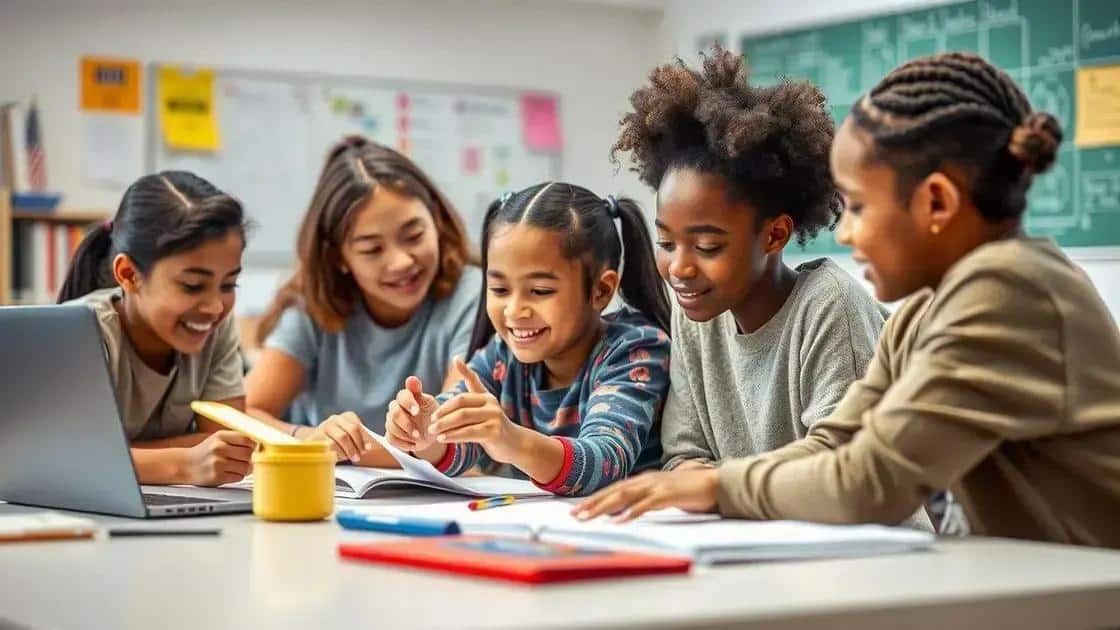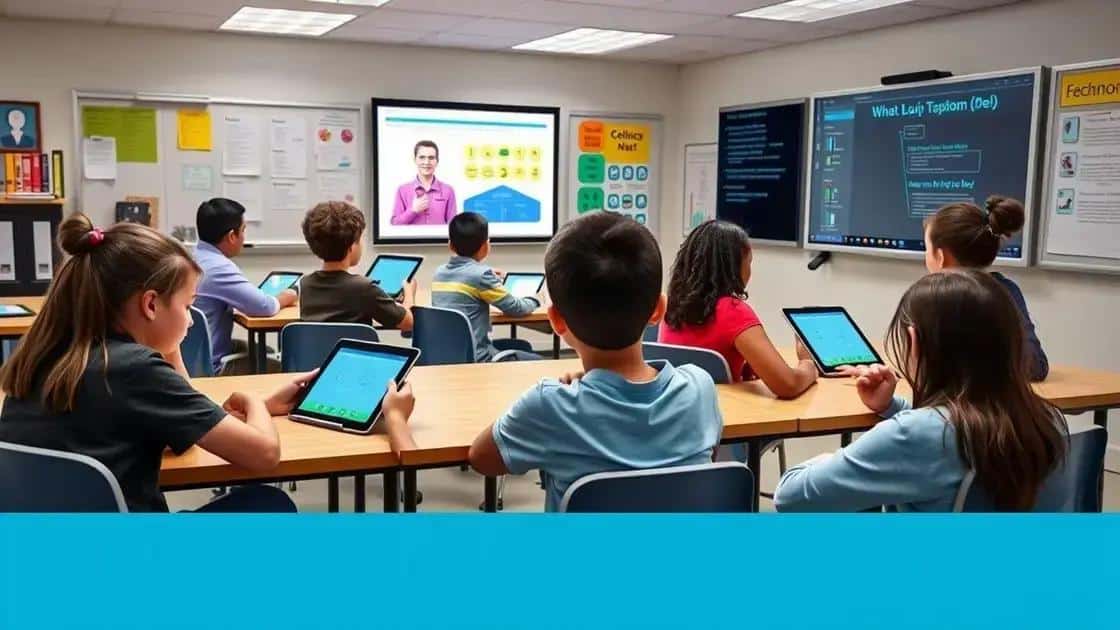One education reform insights that could transform schools

Education reform focuses on personalized learning, technology integration, and social-emotional learning to enhance equity and student success in schools.
One education reform insights can drastically change how we approach learning in schools. Have you ever wondered how new ideas could improve student engagement and outcomes? Let’s explore some transformative concepts that are gaining traction.
The impact of education reform on student success
Education reform has a significant impact on student success. It influences not just what students learn, but how they learn it. By changing the structures of educational systems, we can enhance the overall learning experience.
For instance, modifying curriculum standards can lead to more engaging lessons that resonate with students. Reforming teaching methodologies allows teachers to connect with their students more effectively, fostering a better learning environment.
Key Changes in Education Reform
There are several crucial changes that reforms can bring to education:
- Increased focus on critical thinking skills
- Integration of technology in the classroom
- New assessment methods that focus on real-world skills
Furthermore, providing professional development for teachers can have a profound effect on student performance. When teachers are equipped with the latest strategies and tools, they can create more effective learning experiences.
Creating Inclusive Learning Environments
Today’s educational reforms emphasize inclusivity. By addressing the diverse needs of students, schools can promote equity in education. Ensuring that every student has access to tailored resources and support enhances their chances of success.
On the other hand, involving parents and communities in the reform process can lead to more tailored approaches that fit local needs. Community feedback can shape how schools implement changes that truly benefit students.
In summary, the impact of education reform on student success is profound. Through thoughtful changes to curriculum, teaching methods, and community involvement, we can create a positive environment for learning.
Innovative teaching methods in recent reforms
Innovative teaching methods are at the heart of recent education reforms. They aim to enhance student engagement and improve learning outcomes. Schools are increasingly adopting new approaches that foster creativity, critical thinking, and collaboration among students.
Active Learning Techniques
One key method making waves is active learning. In this approach, students participate actively in their education rather than passively receiving information. Activities like group discussions, problem-solving tasks, and hands-on projects make learning more relatable and meaningful.
- Group projects that promote teamwork
- Debates to enhance critical thinking
- Interactive simulations that bring concepts to life
Such methods empower students to take ownership of their learning, boosting both their confidence and skills.
Project-Based Learning
Another innovative approach is project-based learning. This style revolves around students working on a specific project over time, allowing them to explore real-world problems. They learn by doing, which can deeply engage their interests.
For example, students might collaborate on a project addressing community issues. This real-life relevance encourages them to think critically and apply their knowledge practically.
Teachers also benefit from these methods. With a focus on student-centered learning, they can adapt their teaching styles to better suit the needs of their students. Generally, when teachers embrace innovative methods, they become facilitators of learning rather than mere dispensers of information.
Ultimately, these teaching methods transform classrooms into dynamic learning environments where students thrive and are better prepared for the future.
Role of technology in education transformation

The role of technology in education transformation cannot be overstated. It has reshaped how students learn and how teachers deliver lessons. Using technology, schools can provide more engaging and personalized learning experiences for students.
Blended Learning Environments
One of the significant shifts is the rise of blended learning environments. This approach combines traditional face-to-face teaching with online learning. Students can access digital resources at their own pace, enhancing their understanding of complex subjects.
- Flexible schedules that accommodate diverse learners
- Access to a variety of learning tools and resources
- Opportunities for independent study and exploration
By incorporating technology, educators can tailor their teaching methods to better suit individual learning styles.
Interactive Educational Tools
Technology also introduces interactive educational tools that make learning fun and engaging. Programs such as educational games and simulations allow students to experiment and explore concepts in a hands-on way. These tools encourage critical thinking and problem-solving.
For example, virtual reality can transport students to historical sites or science labs, providing immersive experiences that deepen their understanding of the material.
Moreover, technology fosters collaboration among students. Tools like online forums and collaborative platforms enable them to work together on projects, regardless of their physical location. This enhances their teamwork skills and prepares them for a global work environment.
Incorporating technology in education not only enhances learning but also prepares students for the future. As technology continues to evolve, so too will the ways in which it transforms education.
Addressing equity through educational changes
Addressing equity through educational changes is crucial for ensuring all students have the opportunity to succeed. These changes focus on creating environments where every learner feels supported and valued, regardless of their background.
Importance of Inclusivity
Inclusivity means ensuring that every student has access to the same resources and opportunities. This shift challenges traditional barriers that often lead to unequal learning experiences. For instance, schools are adopting culturally responsive teaching, which recognizes and respects students’ diverse backgrounds and experiences.
- Creating diverse learning materials that reflect all cultures
- Training teachers to understand and address different needs
- Involving families and communities to support student learning
By embracing inclusivity, schools can foster a greater sense of belonging among all students. This promotes not just academic success but also social and emotional well-being.
Equity in Resources
Another area of focus is ensuring that resources are equitably distributed. This means providing additional support to schools in underserved communities. Schools must invest in technologies, facilities, and trained staff to give all students a fair chance to succeed.
In many cases, this may involve shifting funding to support underfunded schools, allowing them access to the same quality of education as their more affluent counterparts. Equity initiatives may also include tutoring programs, after-school activities, and mental health services.
Ultimately, addressing equity through educational changes is about making conscious choices that benefit all students. Schools that prioritize equity help cultivate environments where diverse learners can thrive and realize their full potential.
Future trends in education reform
Future trends in education reform are aimed at creating a more flexible and responsive learning environment. As we look ahead, it is essential to understand how these changes will shape the educational landscape for students and teachers alike.
Personalized Learning
One significant trend is personalized learning. This approach tailors education to meet the individual needs of each student. By using data and technology, educators can identify the strengths and weaknesses of students to provide customized learning experiences.
- Adaptive learning technologies that adjust content in real time
- Student-driven learning paths to enhance engagement
- Regular assessments to monitor progress and adjust strategies
With personalized learning, students feel more invested in their education and can progress at their own pace.
Focus on Social-Emotional Learning
Another trend gaining traction is the emphasis on social-emotional learning. Schools are recognizing the importance of developing not just academic skills, but also emotional intelligence and resilience in students. Programs that focus on self-awareness, empathy, and relationship-building are becoming integral parts of the curriculum.
This focus helps create a supportive school environment, where students learn to manage their emotions and build healthy relationships with peers.
Additionally, incorporating project-based learning and real-world experiences into the curriculum prepares students for future challenges. This hands-on approach encourages critical thinking and collaboration, equipping students with necessary skills for lifelong learning.
Finally, as technology continues to evolve, it will play an even larger role in education reform. Virtual and augmented reality tools are transforming classrooms, making learning more interactive and immersive.
FAQ – Frequently Asked Questions About Education Reform
What is personalized learning?
Personalized learning tailors education to meet the unique needs of each student, allowing them to learn at their own pace.
How does technology enhance education?
Technology provides interactive tools and resources that make learning more engaging and accessible for students.
Why is social-emotional learning important?
Social-emotional learning helps students develop emotional intelligence and interpersonal skills, which are essential for success in school and life.
What does inclusivity in education mean?
Inclusivity in education ensures that all students have equal access to resources and opportunities, regardless of their background.






